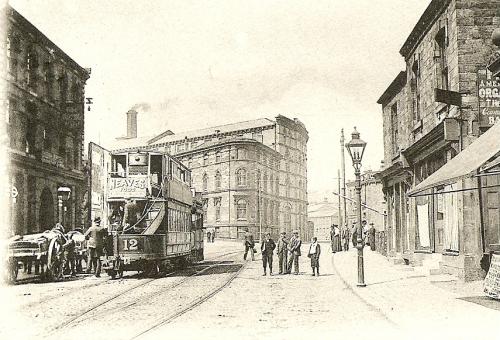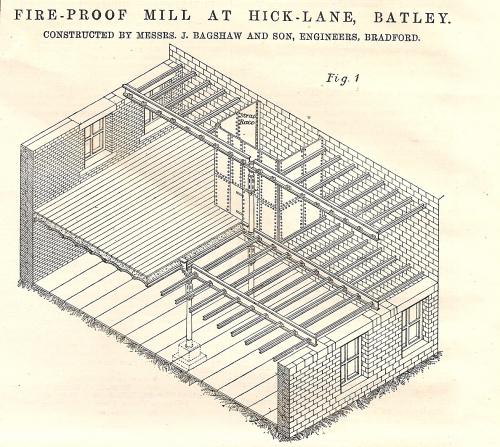Hick Lane Mill

The Beginnings
This mill, again a company mill, founded in 1822, was said to have been the first built for the production of shoddy cloth, and of it James Willans commented that it was "owned by a company of nearly all the principal manufacturers then in Batley, the Speddings, Sheards, Jubbs, Foxes etc"
(In terms of shoddy production, according to a later account, some of these men, Joseph Jubb, John and Phineas Fox, and John Burnley, together with George Newsome, are said to have been those who in 1818 made a rag machine, copying Benjamin Law's idea.)
The mill was on Hick Lane, but the present Bradford Road, for a long while just "New Road" had not yet been built, and it must then have seemed like a continuation of Rouse Mill Lane. A deed of 1823 mentions the right to draw water from the stream known as Wooller Beck to work a steam engine, and to supply the fulling and other stocks and for every other purpose of the said mill and premises. There is no specific mention of rag machines.
It is referred to as: That large and commodious scribbling and fulling mill lately erected and now in the possession of Messrs:-
John Burnley of Havercroft, clothier
Michael Spedding of Batley, clothier
Michael Sheard of Batley, clothier
Joseph Jubb
John Blakeley of Dewsbury
John Fox of Havercroft
Phineas Fox, Soothill, Dewsbury
Benjamin Parr
John Day Havercroft, clothier.
Joseph Wilson
Development and change
Quite who first operated the mill is not wholly clear, a directory of 1829 refers to a firm of Burnley, Spedding & Co as fulling millers, but does not say where. By 1834 the firm of Sheard, Spedding & Co are listed at Hick Lane Mill as flushing and drugget manufacturers.
After a time John Burnley built a mill of his own nearby, Hick Well Mill. He died early in 1836, and in July his heirs pulled out of Sheard, Spedding and Co, then described as scribbling and fulling millers and manufacturers at Hick Lane, leaving Michael Spedding, Michael Sheard, Joseph Jubb and Phineas Fox.
Michael Sheard the Elder's will of 1836 refers to his four shares in Hick Lane Mill, "now in the possession of Messrs Sheard, Spedding and Company" He also mentions his stock in trade, looms, jennies and implements of trade. In 1839 Sheard Spedding & Co advertised for a man to take charge of 2 steam engines at Batley New Mill"
Boiler-tapping riots
We learn that the mill did not escape the boiler plug being drawn in the "Plug Riots" of 1842, (for details of this incident see my account of Michael Spedding )
The firm of Sheard Spedding & Co was dissolved in 1854, by which time the partners were Michael Spedding, George and Michael Sheard, William Fox, shoemaker, and Joseph Parker
Concerning Hick Lane, in "Batley Past and Present" J Willans says :- "after a few years some of the partners having died, and some built other mills, Messrs Michael Sheard and Sons then bought the shares of the other partners and they have added mill after mill, taking the first one down entirely and rebuilt it, besides purchasing Messrs Burnley's Hick Well Mill and rebuilding and enlarging it.
In the 1851 census a firm of three was indicated, Michael and sons John and Joseph, with Benjamin listed as assistant. In 1857 Michael the Elder pulled out of partnership with his sons, the business subsequently to be carried on by his sons John, Joseph and Benjamin, together with George who was brought into partnership at this time, under the name of Michael Sheard and Sons. It was therefore under their regime that Burnley's Hick Well mill, (or perhaps we should say mills, for it was described as comprising two, equipped for the whole process of cloth manufacture including rag grinding rooms and with a fifty horsepower engine) offered for sale in 1861, was purchased.
I think it likely that it was around this time that the office and warehouse building illustrated, and now the sole survivor, was built. Probably Michael, the only brother not to enter the textile trade, hand a hand in the design of this; the styling of the windows bears some resemblance to his Town Hall ones.
Fires!
In 1866 there was a fire in which part of the works burned down, and this was replaced by a large new building used as a mill and warehouses. this is said to have been fireproof and survived the later fire in 1876.
This later fire was described by the Batley Reporter as one of the most destructive that ever ocurred in the neighbourhood. the fire was discovered just before six in the morning of Monday January 24th, when the gas was being lit to commence work, and quickly broke through the roof of the middle section of the mill. We learn that the mills had alarm bells, but it appears that Sheard's could not be safely reached. However, people were on their way to work, and saw that an alarm was raised by ringing Stubley's bell.
With a strong wind the fire spread despite the best efforts of the Batley, Batley Carr and Birstall fire brigades, and roof and walls crashed in. A large crowd assembled to watch, held back by members of the West Riding constabulary to ensure their safety. There was concern for the Bank premises and adjacent cashier's house at the top of Hick Lane, but these were saved. The writer of the newspaper report describes the scene as awfully grand. (Having seen a big mill fire myself in Dewsbury as a child, and that at night, I can vouch for such being an awesome sight.)
Damage was estimated at nearly £40,000 and although there was insurance with two companies, this was not thought to cover the whole amount. Scribbling, spinning and fulling machinery was lost, much of it fairly new. This placed the firm in a difficult situation, for they were engaged in a large order for army cloth, but it was proposed that as much work as possibly would be carried out with night and day shifts at Hick Well Mill and in the remaining portion, hoping thus to continue production and reduce the loss of employment.

Rebuilding
A four storey building replaced that which had been destroyed, and this was of what was termed fireproof construction designed by the firm of J Bagshaw and Sons (of Batley in the accompanying text despite Bradford in the heading), shown here in an illustration from an engineering journal. This was the firm at this date managed by Walter Bagshaw
Here a framework of cast iron columns and beams had brick arches between the intermediate joists, covered with concrete planked over to form the floors. Doors between sections were of boiler plate, and hoists between floors had iron shutters. I imagine cost was a factor in why such construction was not always employed; we are told that 400 tons of ironwork was used.
Decline
Although Joseph had retired from the firm, a chill caught on this occasion, and perhaps the shock, may have contributed to his death. Joseph's executors wished his share of the mill to be paid out, and this is said to have been a heavy blow to the firm. Benjamin was to die in 1891, leaving George at the helm. On January 1st 1894 the firm was registered as a private limited company, with a capital of £80,000; the directors being George, his son Percy, and Joseph Senior Sheard his nephew, son of Benjamin.
The first year following this is said to have been profitable, but there was then a period of decline, the last successful year being 1901. Continued losses in following years compelled the firm to close in 1907, an announcement to that effect being made on Good Friday.
With many jobs involved there must have been local relief when the mill was bought by Stubleys, whose Batley Mills were at that time headed by John and David Stubley.
Fire, despite earlier measures taken, was to bring the end, as on September 25th 1969 a major fire destroyed the whole save for the office section.